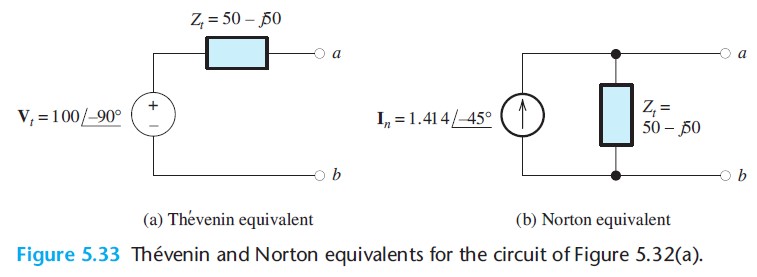Question 5.11: Maximum Power Transfer Determine the maximum power that can ...
Maximum Power Transfer
Determine the maximum power that can be delivered to a load by the two-terminal circuit of Figure 5.32(a) if a. the load can have any complex value and b. the load must be a pure resistance.

Learn more on how we answer questions.
In Example 5.10, we found that the circuit has the Thévenin equivalent shown in Figure 5.33(a). The Thévenin impedance is
Z_t=50-j50~\Omega
a. The complex load impedance that maximizes power transfer is
Z_{\mathrm{load}}=Z_t^*=50+j50
The Thévenin equivalent with this load attached is shown in Figure 5.35(a). The current is
\mathrm{I}_a=\frac{\mathrm{V}_t}{Z_t+Z_{\mathrm{load}}}=\frac{100\angle -90^\circ}{50-j50+50+j50}=1\angle -90^\circ\mathrm{~A}
The rms load current is I_{a\mathrm{rms}}=1/\sqrt{2}. Finally, the power delivered to the load is
P= I^2_{a\mathrm{rms}}R_{\mathrm{load}}=\left(\frac{1}{\sqrt{2}} \right)^2 \left(50\right)=25\mathrm{~W}
b. The purely resistive load for maximum power transfer is
R_{\mathrm{load}}=\left|Z_t\right| =\left|50-j50\right| =\sqrt{50^2+\left(-50\right)^2 } =70.71~\Omega
The Thévenin equivalent with this load attached is shown in Figure 5.35(b). The current is
\mathrm{I}_b=\frac{\mathrm{V}_t}{Z_t+Z_{\mathrm{load}}}=\frac{100\angle -90^\circ}{50-j50+70.71}=\frac{100\angle -90^\circ}{130.66\angle -22.50^\circ}=0.7654\angle -67.50^\circ \mathrm{~A}
The power delivered to this load is
P=I^2_{b\mathrm{rms}}R_{\mathrm{load}}=\left(\frac{0.7653}{\sqrt{2} } \right)^2 70.71=20.71\mathrm{~W}
Notice that the power available to a purely resistive load is less than that for a complex load.

